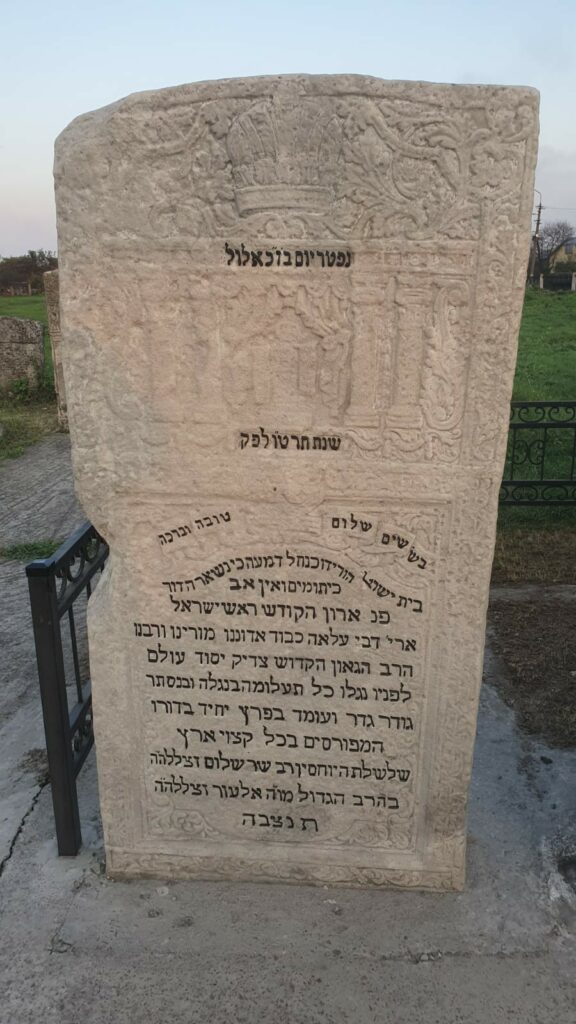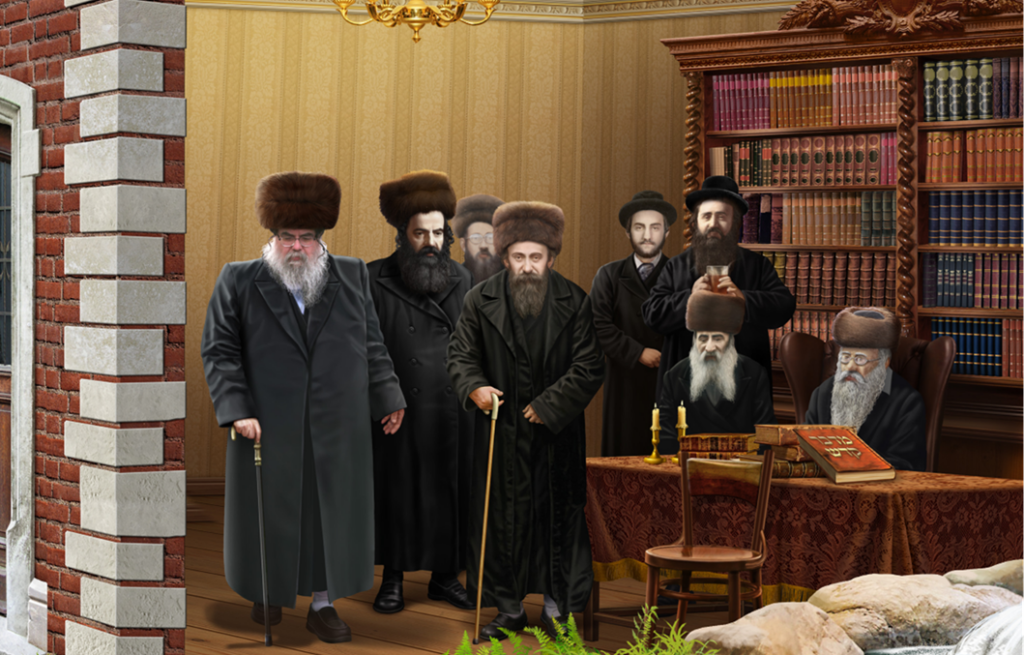

ABOUT – THE HISTORY OF BELZ
The Holy Sar Shalom
A Leader is Born
The founder of the Belz dynasty was Rabbi Shalom Rokeach zt”l. He is known throughout the Chassidic world as the Sar Shalom, but in Belz he is referred to simply as the Ershter Rov Z”L – the First Belzer Rebbe.
Reb Shalom was born in Brod (Brody) to his father, Rabbi Elazer Rockach, approximately 5545 (1785). According to the legend, his father was attending the sick bed of his beloved Rabbi the holy Reb Chayim T’zanzer, praying and crying bitterly as he realised that his Rabbi was slipping away. Suddenly, his Rabbi opened his eyes and, smiling calmly at his weeping disciple, he said: “Do not cry! You have no cause to be so sad, as I will return to you in just one week!”
Shortly after he finished talking, Reb Chayim passed away. His disciple was inconsolable, until just about a week later, at the end of the seven days of mourning; his wife gave birth to a baby boy. The wonder of wonders, he thought, who knows if this is not what my Rebbe meant when he said that he would return to me in one week?!
Indeed from a very tender age it was apparent that this child was destined for greatness.
Indeed from a very tender age it was apparent that this child was destined for greatness. He excelled in his studies and unlike other children he shunned their childish activities, preferring to spend every spare moment in the synagogue. During the festival of Chanuka, when he was still a young boy, he asked permission one evening to go to the synagogue. His father, who assumed he wanted to go and play dreidel with his friends, granted him permission but gave him a candle to take with him, admonishing him to light the candle when he reached the synagogue and to return home as soon as it burnt out. Little Shalom made his way to the synagogue, but instead of playing with his friends, he lit his candle and settled in a quiet corner and immersed himself in the study of the holy books. He was totally absorbed in his studies and did not notice that something wonderful was taking place. The little candle that should have burnt for no more than one or one and a half hours, burned for several solid hours until he finished the complex Talmudic discourse he was studying and only then extinguished. True to his word, as soon as the candle burnt out, he returned home to meet his father’s wrath at what he perceived as an act of disobedience!
At a tender age, he was orphaned when his father passed away. His mother took him to Sokal, where he grew up in the home of his uncle Rabbi Yissochor Dov Ramraz, who served as the Rabbi of Sokal. When his uncle came to realize the merits of his young nephew, he was so impressed that he took him for a son-in-law and gave him his daughter Malka’s hand in marriage.
The Torah King
Rebitzen Malka proved to be a worthy partner and soul mate, and she stood resolute and steadfast at her husband’s side, encouraging and supporting him as he proceeded painstakingly along his chosen path. She was renowned for her great compassion for her fellow Jews, and to this day Chassidim tell great and wonderful tales about her legendary saintliness and her noble deeds, but above all her great husband never forgot what she had done for him when he was young and struggling. Indeed it is said about her: “It is for the merit of Malka (the Hebrew word for Queen) that Shalom is a King!”
Reb Shalom’s remarkable perseverance and ability to spend hour upon hour immersed in the study of Torah is highlighted by another amazing story. Shortly after his marriage to the saintly Rebbitzen Malka he embarked on a mission to test his perseverance and endurance. He and two partners undertook a seemly impossible task – to spend 1000 consecutive nights studying the Word of G-d and searching for the illusive mysteries that are imbedded therein.
The first of the two partners gave up after a mere 300 nights, the second dropped out after some 700 consecutive nights, but Reb Sholom alone persevered.
On the thousandth night a terrible storm broke out with heavy rains, hail and thunder. It was as if the very Devil himself had come to bar his way and prevent him from reaching his goal. The dauntless young man struggled through the storm and reached the synagogue. As he sat down to learn, the great winds were so powerful that they smashed the windows and extinguished his candle. In distress, he went to the Holy Ark and cried: “Oh Hashem! Please help me and do not let this storm disrupt my learning schedule!”
The immortal prophet Eliyahu Hanovi was revealed to him and throughout the remainder of the night he disclosed to him the mysteries of the Torah.
Almost at once the terrible storm died down and Reb Sholom rekindled his candle and resumed his studies. But this time, he did not study alone. The immortal prophet Eliyahu Hanovi was revealed to him and throughout the remainder of the night he disclosed to him the mysteries of the Torah. He introduced him to the wellsprings of the Cabbala and presented him with the keys to the vaults of the most secret and inscrutable mysteries that are embedded in the Torah.
As the memorable night drew to a close, Reb Sholom made a resolution: he undertook to build a mighty house of prayer that would incorporate every aspect of holiness exactly as he had learned from the immortal prophet because the last subject that they discussed that night pertained to the laws of building a synagogue as a house of prayer.
Anointment of the First Belzer Rebbe
Every day, come rain or shine, even in the hail or snow of the bitterly cold winter days, Reb Sholom would stand and participate physically in the construction of the House of the Lord.
Reb Shalom was appointed as Rabbi in Belz in 5576 (1816), and shortly afterward, he began his ambition. He spared neither effort nor money on his holy project that took fifteen years to complete. He was not content to merely draw up the plans and give instructions to the masons and bricklayers. Every day, come rain or shine, even in the hail or snow of the bitterly cold winter days, Reb Sholom would stand and participate physically in the construction of the House of the Lord.
The resulting edifice was truly a sight to behold. It was built with a castellated roof and battlements in the style of the fortified synagogues that were once common, and of which some are still in existence today in Central and Eastern Europe. Not only was it an architectural masterpiece but it also complied with every Halachic and Cabalistic law and guideline regarding, for example, the number of windows and their locations and the positioning of the doors etc. He even claimed that he had not merely built his synagogue to face towards East, as is customary, in the general direction of Zion, he had positioned his synagogue to face precisely towards the Temple Mount in Jerusalem and that, furthermore, no church or idol obstructed the direct line to the holy location!
He literally took the concept Le’romeam Beis Elokeinu – to elevate the House of our Lord. Not only was his synagogue architecturally far superior to any other building in the vicinity, but he insisted that it must also be physically the highest. When a local nobleman started to build a church across the street and according to the plans he submitted, his building would have been slightly higher that the synagogue, Reb Sholom modified his plans and elevated the overall height by adding ornamental battlements to the top of the main synagogue building.
The nobleman laughed when he heard of the new plans and said: “The Rabbi does not realise that I am a reincarnation of Haman! As often as he elevates his building so will I elevate mine and we will see whose building will be higher!”
When his scornful statement was conveyed to the Rebbe he responded: “Well if he has likened himself to Haman he will have a downfall just as Haman had!” That very day, as the nobleman was riding into town to present his modified plans to the planning committee, he was thrown by his horse and killed.
The Holy Synagogue/Belzer Shul
Twelve of the most beautiful synagogues in the Diaspora will be relocated in Jerusalem close to where Hashem will rebuild his temple and my synagogue will be one of them!
During the synagogue’s inauguration ceremony the Rebbe said that when Mashiach comes, and the Jews will be gathered from the four corners of earth to the Land of Israel, their synagogues, and their houses of studies will be gathered with them and transplanted in the Holy Land. Twelve of the most beautiful synagogues in the Diaspora will be relocated in Jerusalem close to where Hashem will rebuild his temple and my synagogue will be one of them!
Reb Shalom’s building was indeed beautiful and elaborate, but above all, he imbedded Kedusha – holiness, in the very masonry of the synagogue. One day, shortly after the synagogue’s inauguration, the blind saint Rabbi Shimon of Yaroslav visited Belz, and Reb Shalom took him to show him around his new synagogue. It was indeed a wonderful sight to behold how the holy guest entered the synagogue, placed his hands on the wall, and started walking around the building murmuring ecstatically: “Good! Good! Wonderful!” Occasionally he leaned over and kissed the walls. The onlookers were surprised when he reached one particular section and withdrew his holy hands as if displeased. After continuing several paces, he started tapping and stroking the walls again.
“Yes, yes!” Reb Shalom said softly, not looking in the least surprised, “unfortunately I was not present when this section was built…” Undoubtedly the Chassidim who built the synagogue tried their best to build it with the greatest piety and all the holiness that they could muster, but they were not able to breathe their very souls into the brickwork or to infuse the cold masonry with the fervour of their hearts. Only Reb Shalom was capable of doing so, and only a saint like the blind Reb Shimon of Yaroslav could perceive it!
The tips of the ornamental battlements were adorned with gilded copper balls that caught the sunlight and in ideal weather conditions could be seen twinkling from far away. Some say they could be seen as far as sixty kilometres from Belz. They served as a beacon for the pilgrims as they made their way to Belz, reassuring them that they were getting close to their destination.
During the First World War the Russians occupied Belz. They billeted their troops in the Rebbe’s mansion, set up a field hospital in the House of Study and bedded their horses in the holy synagogue. They stole and destroyed many priceless and often irreplaceable objects and desecrated the holiness of these wonderful buildings, but perhaps, the most noticeable of all was that they plundered the gilded balls that adorned the roof. They were taken down and melted to make ammunition.
Besides the famous synagogue, Reb Shalom built another memorable building. He built a residential mansion to house him and his family and incorporated therein a large hall where Chassidim gathered on Shabbos and Jewish festival to participate in the Rebbe’s festive meals – the Tish. However this was no ordinary residential building. The holy Rabbi Moshe of Lelov visited Belz in 5610 (1850) to take leave of the Sar Shalom before immigrating to the Holy Land. He is recorded as saying that the famous synagogue is indeed a wonderful building; however, over the years, he has had the privilege to see many great and holy synagogues and houses of study. But never has he seen a residential building imbued with such holiness – a Kedusha that surpasses even most synagogues. Anyone who could build a residential building like that was indeed worthy of his utmost admiration!
Reb Shalom’s Passing
Reb Shalom reined in Belz for close to forty years, until he passed away in the year 5615 (1855) just three days before Rosh Hashana – the Jewish New Year. During his eulogy at the funeral, his successor, the holy Rabbi Yehoshua, proclaimed that his saintly father was taken from the world three days before Rosh Hashana because he had been appointed as a member of the judicial panel in the Heavenly Court and according to Jewish law a judge must be given three days notice to prepare himself before assuming an appointment as a judge.

Stories of the Holy Sar Shalom


INSPIRE YOUR INBOX.
Enjoy a weekly dose of Chassidic insights, highlights and happenings.
